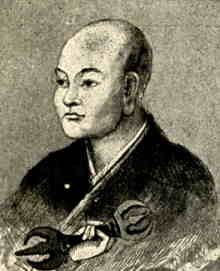SelfDefinition.Org
Sokushin-Jobutsu-Giby Kukai
(Kobo Daishi)
Principle Of Attaining Buddhahood With The Present Body
Translated by Hisao Inagaki

Kukai Index
Attaining Buddhahood With The Present Body, Contents
Cautionary Note
In Zen history and practice, things are not always as we are led to believe ... tl;dr pederasty
From: History of Zen Buddhism by Heinrich Dumoulin, 1963, chapter "First Encounter Between Zen and Christianity". Large file, 363 pages, 10 megs: www.gwern.net, Translated from the German by Paul Peachey (search on "pederasty")
Two circumstances, however, seriously impaired the encounter between Zen and Christianity at the dawn of the modem period. In the first place, at the end of the Muromachi period, [in Japan, approximately 1336 to 1573] Zen was in a state of decline. Not only was religious impulse stifled by cultural and artistic interests, but as a result of the unremitting political and social confusion, temple life was corrupted by both spiritual decay and moral degeneracy. The picture was thus a dark one, which precluded a fair evaluation of the movement as such. Zen followers appeared to the missionaries as atheists and nihilists. Missionaries were scandalized at the widespread practice of pederasty in the temples. (note 2).
Note (2) Regarding this, cf. the testimony of the letters of Francis Xavier and many missionaries, in Schurhammer-Wicki, ed., p. 188; Schurhammer-Voretzsch, tr., pp. 9 f., 338 f.; Torres in Schurhammer (1), p. 47; Valignano in Schiitte, p. 112 . The Portuguese captain Jorge Alvarez, a good observer and one of the few Europeans to visit Japan (1547) before the arrival of the missionaries, "was horrified by the prevalence of sodomy, especially in the precincts of Buddhist temples." See Boxer, p. 35. This matter is discussed most fully by Schurhammer (2), pp. 80- 97. Various missionaries, citing Japanese sources, attribute the introduction of pederasty in Japan to Kobo Daishi (Kukai, a.d. 774-834). See Schurhammer (2), p. 89; cf. Schurhammer (3), pp. 206-28. Tsuji, the historian of Japanese Buddhism, asserts that pederasty was widespread in Zen temples. The earliest mention of this abuse is found in a decree of the Shogun Hojo Sadatoki to the Engakuji temple in Kamakura in the year 1303. Subsequent to this, instructions were issued repeatedly regarding the living arrangements, clothes, etc., of the handsome boys. The literature of the "Five Mountains" (Gozan Bungaku) contains many love songs addressed to boys. See Tsuji (1), pp. 335-37.
See page 199 of this PDF for the quoted chapter, and page 309 the footnote. 10 meg file: https://www.gwern.net/docs/
Link at Terebess.Hu, HUGE file, 52 megs, scan with OCR (page numbering same as above): https://terebess.hu/